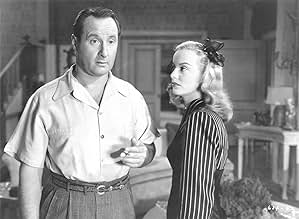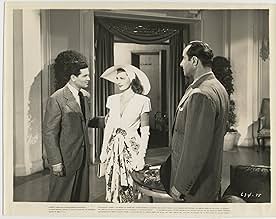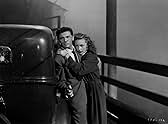NOTE IMDb
7,1/10
2,1 k
MA NOTE
Ajouter une intrigue dans votre langueEx-GI Nick Blake gets involved in a scheme to fleece a rich, young widow, but finds himself falling for her, much to the displeasure of his racketeer cohorts.Ex-GI Nick Blake gets involved in a scheme to fleece a rich, young widow, but finds himself falling for her, much to the displeasure of his racketeer cohorts.Ex-GI Nick Blake gets involved in a scheme to fleece a rich, young widow, but finds himself falling for her, much to the displeasure of his racketeer cohorts.
- Réalisation
- Scénario
- Casting principal
Richard Erdman
- Bellboy at The Marwood Arms
- (as Dick Erdman)
Fred Kelsey
- Railroad Conductor
- (scènes coupées)
Robert Arthur
- Bellhop
- (non crédité)
John Barton
- Barfly
- (non crédité)
Ted Billings
- Barfly
- (non crédité)
Jack Chefe
- Hotel Waiter
- (non crédité)
Adrian Droeshout
- Bar Patron
- (non crédité)
Avis à la une
A very usual plot covers this story. A manipulator wants to fleece a wealthy widow but falls for her instead. The problem is that he had made previous commitments with other hoods to take this woman for a ride.
John Garfield is perfect as Nick. He falls for Mrs.Halverson, a wonderful Geraldine Fitzgerald.
The gang is in top form with Walter Brennan as Pop, George Coulouris'Doc is excellent. By the way, for a hood Coulouris speaks very well and in fact sounds like a very educated person in some scenes. George Tobias really provides some comic relief, but in a straight role as Nick's sidekick.
You wonder why the Fitzgerald character can't fall in love with her financial adviser, nicely played by Richard Gaines. The two seem to be a perfect match but I guess there would be no story if that occurred.
Faye Emerson is the dame that Nick had previously hooked up with. She is a real hot number here. Few realize that in real life she had been married to Eliot Roosevelt, FDR's son.
John Garfield is perfect as Nick. He falls for Mrs.Halverson, a wonderful Geraldine Fitzgerald.
The gang is in top form with Walter Brennan as Pop, George Coulouris'Doc is excellent. By the way, for a hood Coulouris speaks very well and in fact sounds like a very educated person in some scenes. George Tobias really provides some comic relief, but in a straight role as Nick's sidekick.
You wonder why the Fitzgerald character can't fall in love with her financial adviser, nicely played by Richard Gaines. The two seem to be a perfect match but I guess there would be no story if that occurred.
Faye Emerson is the dame that Nick had previously hooked up with. She is a real hot number here. Few realize that in real life she had been married to Eliot Roosevelt, FDR's son.
This is certainly not one of John Garfield's more famous films and it's very possible you have never heard of it or seen it. It is about a con man who finds a rich woman who he intends to swindle. And, due to his smooth and effortless way of lying and ingratiating himself, she soon falls head over heels for the rat! However, despite his supposed heart of stone, he finds that he really does care for the woman and can't bring himself to hurt her. This is a serious problem, as Garfield's cohorts are definitely NOT nice people and he knows they will kill him if he double-crosses them.
This film is a satisfying mix of romance and film noir that deserves a chance.
This film is a satisfying mix of romance and film noir that deserves a chance.
Nobody Lives Forever (1946)
This is a quirky but good film. If technically a film noir in tone and structure, it largely lacks the darkness of intention in any of the main characters. Part of this comes from the casting—John Garfield is just too sweet a guy to pull off a devious, malicious scammer, and Walter Brennan as the sidekick couldn't appear evil if he tried.
There are some classic noir elements which make the movie fun, like a nightclub (and nightclub owner), a femme fatale (played with restraint by Faye Emerson), and a host of thugs who are convincing (this is Warner Bros. after all). The main plot is a kind of crime romance, where Garfield, an ex-con man playing a returning soldier, has half an intention to go straight but then gets roped into one last big scam. The victim is a rich young widow, and as Garfield goes after his mark he naturally falls in love. The people backing Garfield have a stake in his success and they don't like what's going on—he could just marry the widow and they'd be left in the cold.
So there is a turning of who is against who in the scenario. And this matters, but a lot of the first half of the movie is about the growing romance between the two leads. And it doesn't quite take off. I suppose it was important to make this widow a straight up type, a "good" woman," but casting Geraldine Fitzgerald made sure the chemistry would be restrained. You do want these two very nice people to make it, but it's not spiked with anxiety enough, or dreamy highs enough, to make you quite get swept away.
Where it gets interesting is when the thugs get in the way. The plot takes some terrific twists, and there are some some terrific atmospheric scenes at a pier in the second half of the movie, with large pumps running and the mist rolling by at night. People's better natures are revealed. A tragedy for one man becomes a lesson for our leading couple.
Director Jean Negulesco, though not as well known as a dozen of his contemporaries, made a series of strong, highly dramatic movies after the war that are often worth watching just for their moods. Here he uses legendary cinematographer Arthur Edeson ("Casablanca," "Frankenstein") to make this mood memorable and visually stunning. Throw in the usual high standards of Hollywood, and Warner Bros., at the time and you have a lot of why this movie, whatever its flaws, is still completely absorbing. Well worth watching.
This is a quirky but good film. If technically a film noir in tone and structure, it largely lacks the darkness of intention in any of the main characters. Part of this comes from the casting—John Garfield is just too sweet a guy to pull off a devious, malicious scammer, and Walter Brennan as the sidekick couldn't appear evil if he tried.
There are some classic noir elements which make the movie fun, like a nightclub (and nightclub owner), a femme fatale (played with restraint by Faye Emerson), and a host of thugs who are convincing (this is Warner Bros. after all). The main plot is a kind of crime romance, where Garfield, an ex-con man playing a returning soldier, has half an intention to go straight but then gets roped into one last big scam. The victim is a rich young widow, and as Garfield goes after his mark he naturally falls in love. The people backing Garfield have a stake in his success and they don't like what's going on—he could just marry the widow and they'd be left in the cold.
So there is a turning of who is against who in the scenario. And this matters, but a lot of the first half of the movie is about the growing romance between the two leads. And it doesn't quite take off. I suppose it was important to make this widow a straight up type, a "good" woman," but casting Geraldine Fitzgerald made sure the chemistry would be restrained. You do want these two very nice people to make it, but it's not spiked with anxiety enough, or dreamy highs enough, to make you quite get swept away.
Where it gets interesting is when the thugs get in the way. The plot takes some terrific twists, and there are some some terrific atmospheric scenes at a pier in the second half of the movie, with large pumps running and the mist rolling by at night. People's better natures are revealed. A tragedy for one man becomes a lesson for our leading couple.
Director Jean Negulesco, though not as well known as a dozen of his contemporaries, made a series of strong, highly dramatic movies after the war that are often worth watching just for their moods. Here he uses legendary cinematographer Arthur Edeson ("Casablanca," "Frankenstein") to make this mood memorable and visually stunning. Throw in the usual high standards of Hollywood, and Warner Bros., at the time and you have a lot of why this movie, whatever its flaws, is still completely absorbing. Well worth watching.
Geraldine Fitzgerald gets the glamor treatment here as a young widow about to be bilked by ex-soldier John Garfield in this post-war film. Both stars give wonderful performances and are ably supported by a neat cast consisting of Walter Brennan, Faye Emerson, George Coulouris, George Tobias, and Richard Gaines. Garfield, an experienced con man, comes back from the war changed. Drawn into a scheme to con a rich widow, he finds himself falling for her instead.
The stars are lovely together, and the film has a rich atmosphere throughout, each setting clearly defining the moment. The nightclub scenes evoke the '40s postwar feeling, the California scenes are bright and sunny, and the scenes on the pier are spooky and dense with fog. A very good film.
The stars are lovely together, and the film has a rich atmosphere throughout, each setting clearly defining the moment. The nightclub scenes evoke the '40s postwar feeling, the California scenes are bright and sunny, and the scenes on the pier are spooky and dense with fog. A very good film.
Of all the Hollywood writers now associated with classic film noir --among them James M. Cain, Raymond Chandler & Dashell Hammett the least known and perhaps least appreciated is W.R. Burnett who was responsible for the story and often the screenplay of a number of film crime classics, among them the films Scarface, Little Caesar, High Sierra and Asphalt Jungle. Burnett's dialog is as sharp and tough as the others, and he often displays a finer insight and even greater sympathy for the criminal mind than the others whose stories feature and sometimes romanticize the hard-boiled detective. This excellently directed and photographed film tells the story of a charming con-man, perfectly played by John Garfield, who falls for the widow he is trying to cheat. The petty crooks who people his world played by a superb cast of character actors (George Coulouris, Walter Brennan, George Tobias) are all clearly drawn and don't resemble the usual cliché gang members of other films. Burnett obviously knew this world better than his colleagues.
Le saviez-vous
- AnecdotesAccording to TCM's Eddie Muller, screenwriter W.R. Burnett was paid five times for this story. Warner Bros. initially paid him for an original screenplay in 1941. But, per his contract, Burnett took back the rights to his work when the film wasn't made within a specified amount of time. His work was the published in serial form in Collier's magazine in 1943, then published as a novel by Knopf that same year. Warner Bros. then paid him $20,000 ($425,000 in 2024) for the film rights to his novel and paid him yet again to write the screenplay.
- GaffesAs Pop is proposing the con on the widow to Nick and Al, the same couple (a blonde and a man in a vertically striped robe) walks past the window along the beach from right to left twice.
- Citations
Nick Blake: People like me don't change.
- ConnexionsFeatured in Los Angeles Plays Itself (2003)
Meilleurs choix
Connectez-vous pour évaluer et suivre la liste de favoris afin de recevoir des recommandations personnalisées
- How long is Nobody Lives Forever?Alimenté par Alexa
Détails
- Date de sortie
- Pays d’origine
- Langue
- Aussi connu sous le nom de
- Niko ne zivi vecno
- Lieux de tournage
- Mission San Juan Capistrano - 26801 Ortega Highway, San Juan Capistrano, Californie, États-Unis(Nick and Gladys tour the mission)
- Société de production
- Voir plus de crédits d'entreprise sur IMDbPro
- Durée1 heure 40 minutes
- Couleur
- Rapport de forme
- 1.37 : 1
Contribuer à cette page
Suggérer une modification ou ajouter du contenu manquant

Lacune principale
By what name was Nobody Lives Forever (1946) officially released in India in English?
Répondre
































